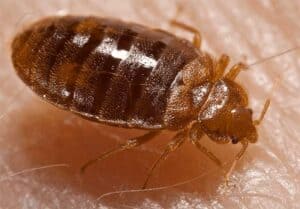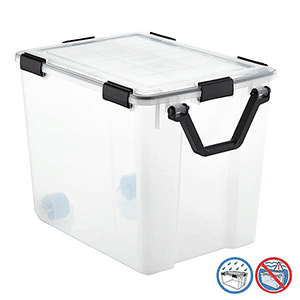How To Perform A Bed Bug Inspection

Do you have an suspicion that your home or apartment may have bed bugs? Maybe you woke up with a rash, or have seen a tiny dark spot or two on your bed sheets. Or maybe you have actually seen the tiny bed bug, but are looking to verify if it was a one-off (probably not if it was an actual bed bug that you spotted) or if you indeed have an infestation. Whatever the situation you find yourself in, EnviroPest is here to help. Here is some advice from our pest control experts on how to go about a proper bed bug inspection in your home.
- Tools that you’ll need for a proper bed bug inspection
- The proper way to inspect your bed for bed bugs
- Don’t forget about the furniture in your bedroom – bed bugs can hide there
- Inspect the rest of the room for bed bugs
- Where else in the home will bed bugs hide?
If you perform a bed bug inspection and still are not sure what you are dealing with, or if you would rather have a professional take a look (highly recommended), please give us a call. We are happy to help you resolve any bed bug problems that you encounter.
Tools that you’ll need for a proper bed bug inspection
Bed bugs are a serious issue in the pest control industry. Different companies have different approaches to addressing the problem. Make sure your prepared by doing your own inspection with these bed bug inspection tools. At EnviroPest, our thorough and rigorous inspection process means that we check multiple areas throughout your home.
Before you call us, however, there are a number of steps you can take on your own to help determine if bed bugs really are the cause of your concern. The first thing you need to do is make sure you know what a bed bug looks like. Then grab the necessary tools. These are the same ones we use in our professional inspections. From there you can be on the lookout for some telltale signs that indicate the presence of bed bugs.
Tools of the Trade
- Magnifying glass
- Strong flashlight
- Plastic zip-top bags for collecting specimens
- Probe, such as a “credit card tool,” made by cutting any plastic card into a long triangle, for checking in narrow spaces
- Pyrethrin or compressed air (used for cleaning computers) for flushing bedbugs from cracks and crevices
- Screwdrivers for removing light switch and electrical plates
- Other tools (a small tool kit) for disassembling furniture
- Alcohol, glass-cleaning or baby wipes, for evidence that stains are bed bug droppings
- Cotton swabs for checking stains in crevices
- Sticky traps may be useful if placed under the bed and checked regularly
Signs of Life
You’ve gathered the proper tools, but before you embark on your search it’s important to know what, exactly, you’re looking for. Distinct signs of bed bugs include the following:
- Live bed bugs: ranging in size from poppy seed to apple seed
- Droppings: usually dark colored stains on cloth or bumps on hard surfaces
- Shed skins: discarded after each of five stages of growth
- Eggs: very small, found among droppings or in crevices where adults hide
Bed Bug Preparation After Inspection
Proper preparation is an essential step for ensuring the most effective results from your upcoming bed bug treatment. Importantly, EnviroPest will provide detailed instructions on what you need to do before your scheduled treatment in the following document. Preparation involves everything from providing adequate access to your unit or property, to cleaning and post treatment recommendations. We understand that appropriate preparation can be difficult to achieve in a short period of time and that senior citizens or handicapped individuals may need additional assistance and time considerations
If you discover bed bugs in your home, contact EnviroPest Exterminators for immediate relief. Our certified team is educated in the most advanced bed bug protocols and equipped with the state-of-the-art resources necessary for complete eradication of these pests. We’re the exterminators NY trusts and we look forward to discussing your issue.
Performing A Proper Bed Bug Bed Inspection
A bed bug bed inspection for bed bugs should start where you sleep and move out from there to other parts of the bed. It’s best to conduct this search before room preparation steps are taken or pest control experts are called in. The lists below will help you make the most complete inspection possible without a professional.
Mattress Inspection During A Bed Bug Bed Inspection
- Along the top and bottom seams and along each side of the piping material sewn onto these edges
- Under mattress handles and along or inside air holes
- Between the mattress and box spring, platform or frame
- Inside folds of material and under buttons
- If covered in vinyl plastic, inside seams and rips in material
If you think you see bed bug droppings, rub the area with alcohol or baby wipes. If the spots dissolve into a reddish brown color, this could indicate bed bug droppings and should be a reason to continue your inspection until a live bed bug is found.
Box Spring Inspection During A Bed Bug Bed Inspection
- Points where the box spring sits on the bed frame (lift slowly to avoid scattering bed bugs)
- Top surface of the box spring, inside folds of material
- Along seams and where the material is tacked to the frame
- In spaces between box spring frame parts (turn over the box spring and remove the thin cloth layer on the underside, then use a flashlight, a hand lens and a crevice tool)
- Around and beneath furniture staples and tacks
It’s a good idea to use a flushing agent (such as compressed air) to chase bed bugs out of hiding spots during your inspection of these areas.
Here’s another inspection trick: place double-faced tape or carpet tape on the underside of furniture to catch wanderers. Note that this is a monitoring tool only, though, and not a control strategy!
Bed Frame and Headboard During A Bed Bug Bed Inspection
Bed bugs prefer wood beds and headboards to metal bed frames, but they’ll hide in crevices on metal and plastic, or where a mattress touches a metal frame. Here are tips for making the most of your frame and headboard inspection:
- Visually inspect and use the crevice tool in all joints of the frame where parts meet
- Turn the frame over and inspect from the underside
- Check screw and nail holes for bed bugs
- Take the bed apart to check between parts
- Remove the headboard from the bed and check for bed bugs along the joints and on the wall behind it
- Wicker furniture provides infinite hiding spots for bed bugs. Anything made of wicker should probably be discarded properly.
It’s important to note that even if the bed area does not display outward signs of bed bugs, you may still have a bed bug problem. It’s crucial to continue your inspection in other areas.
Bed Bug Furniture Inspection:
Starts With Taking Your Time
Bedroom furniture such as nightstands will be likely places to find bed bugs. As the bed bug population grows, overcrowding may cause them to wander. Start a bed bug furniture inspection near the bed because it can easily become infested—and infestation can quickly spread beyond the bed area if control measures aren’t taken.
The Best Ways to Inspect Furniture/Storage Areas:
- Empty drawers and shelves of the furniture closest to the bed
- Place items into plastic bags to be inspected and cleaned
- Pull out drawers and inspect every corner and the undersides, using the crevice tool to check under the metal drawer guide
- Use the crevice tool to inspect gaps wherever the tool will fit, such as between the shelf and bookcase frame
- Turn over all furniture to inspect the underside
- Be sure to inspect screw and nail holes
- Plastic and metal furniture may harbor bed bugs, follow the same inspection procedures
- Electronics, such as lamps, remote controls, alarm clocks, and radios should be placed into plastic bags for further inspection. If bed bugs are found in the frame of the furniture where the radio or clock sits, further inspections of those items and possible treatment are warranted
Quick Fact: Bed bugs only come out in the dark. This is a learned trait.
- Office-style chairs should be inspected by turning them over and looking under seams where fabric attaches to the frame. Also check screw holes
- Plush furniture, such as a couch, will harbor bed bugs, even if residents are not sleeping there. In these cases, inspection will be more difficult due to the many inaccessible hiding spots.
- Inspect pillows and cushions, particularly the seams and the folds around zippers
- Look at and under legs of chairs and couches
- Turn over the furniture and remove the thin cloth backing under each piece
- Pay special attention to staples and where material is stapled to the frame
- Look inside at all wood parts of the frame
- If the piece is highly infested, consider disposing of it in a proper manner (we’ll cover this topic in a later blog in this series)
The final stage of checking a room thoroughly for bed bugs is inspecting the perimeter of the space.
How To Do A Bed Bug Room Inspection
Once established, bed bugs will spread out toward the perimeter of the room, including walls, moldings, and rugs. They will also burrow between cracks, edges and crevices. To cover all your bases and ensure that a thorough bed bug room inspection of the area has been completed, follow the steps below.
Inspect the Room Perimeter
- Look at moldings or the joint between the floor and wall closest to the bed
- Use the crevice tool to check behind moldings. The tool will chase bed bugs out of hiding if used in a sweeping upward motion
- Fold back the edges of wall-to-wall carpets to inspect for signs of bed bugs
- Pay attention to the tack strip of carpets
- Look under the edges of area rugs
- Using a screwdriver, remove electrical switch and outlet, and phone jack plates to inspect. If bed bugs are hiding in these areas, signs may be evident along the edges and on the back of the plate
- Inspect everything hanging on the walls. If framed art or photos are present and there is evidence of bed bugs nearby, open the frame to inspect inside or under the paper backing
- Check under loose wallpaper and areas of peeling paint
- Take down curtain rods and inspect inside them and underneath hardware on the walls
- Look at closet, bathroom and other door frames, along hinges, and in the bore hole for the latch on each door
- Make a note if bed bugs are found on walls; they may be hiding under ceiling moldings and in smoke detectors
- Ceiling lights and fixtures with bed bugs could indicate that they are moving from the upper floor unit
Although the bed is the most common place for bed bugs to infest, other areas are equally susceptible to them.
Where To Look For Bed Bugs
The common bed bug (Cimex lectularius) has long been a pest to people, feeding on blood, causing itchy bites and generally irritating their human hosts. The Environmental Protection Agency (EPA), the Centers for Disease Control and Prevention (CDC), and the United States Department of Agriculture (USDA) all consider bed bugs a public health pest. Unlike most public health pests, however, bed bugs are not known to transmit or spread disease.
What To Inspect To Find Bed Bugs In Your Home
Bed bugs may turn up in unexpected places as a moderate or even large infestation. If the infestation is large, every object in the affected area should be carefully inspected. Bed bugs thrive in tiny cracks and crevices so no item is too small for them to find a home in. Therefore, be sure to take your time during a bed bug inspection.
Through our years of experience in bed bug inspection, we’ve found bed bugs in such unusual locations as:
- Battery compartments of TV and other remote controls
- Telephones, cell phones and cordless phones
- Lamps and alarm clocks
- Computers and other electronics
- Cardboard boxes in closets and under the bed
- Children’s toys and stuffed animals
- Jewelry boxes
- Brick walls and “popcorn” or other textured ceilings
- Books, magazines, newspapers and files
- Inside hollow doors
- Ceiling light fixtures, smoke detectors
- Heating units, air conditioners and ducts
- Wheelchairs
Be sure to check these items if you had a bed bug problem recently or suspect you might currently have an issue. Some tools and household products that will make your inspection easier and more thorough can be found here. It is always better rigorously inspect any locations that might have been infested to guarantee you don’t end up with an even larger issue. If you need help, EnviroPest’s knowledgeable and trained staff will happily help rid your home of bed bugs!
How To Avoid Bed Bug Issues When Moving:
- Step 1 – Laundry: Wash, dry and bag all the laundry and fabrics. Do not take these items back into the apartment. Bag and label all of them at the
laundromat and pack them up. Read up on our laundry prep to find out more.
- Step 2 – Bins: Place all the small items in bin. Buy a Steamer (check out our recommended steamer here) and steam everything before placing it into the bin. Throw anything out that you don’t need or want to keep. Don’t bother moving it. The less items the better. Steam every square inch of every piece of the item before placing in the bin. Make sure it’s non-porous and cleaned. Seal the bins and store in a outside location making sure there is no exposure to bed bugs.
- Step 3 – Furniture: Easiest way is to leave or throw out the furniture. If you want to keep the furniture move it to a garage of storage area. Then a professional would come in and treat the furniture and once it dries then move it.
- Step 4 – Final Clean: Remove items from bins. Re steam clean each item before placing it. Also steam and treat all the furniture once you place it in the locations.
If you discover bed bugs in your home, contact your local NY EnviroPest bed bug exterminator for immediate relief. Our certified team is educated in the most advanced bed bug protocols and equipped with the state-of-the-art resources necessary for complete eradication of these pests. We’re the exterminators NY trusts and we look forward to discussing your issue.


 laundromat and pack them up.
laundromat and pack them up. 
